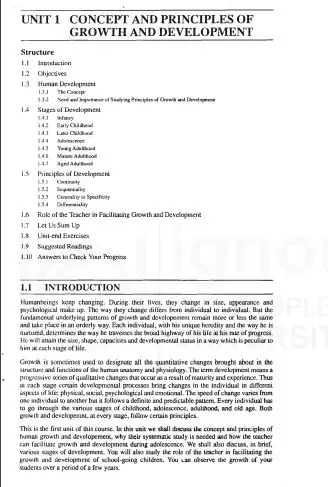‘Explain Principles Of Growth And Development’ PDF Quick download link is given at the bottom of this article. You can see the PDF demo, size of the PDF, page numbers, and direct download Free PDF of the Concept of Children Growth and development using the download button.
Principles Of Growth And Development of Children B.Ed Notes PDF Free Download

Concept of Human Growth And Development
Human beings keep changing. During their lives, they change in size, appearance, and psychological makeup. The way they change differs from individual to individual.
However, the fundamental underlying patterns of growth and development remain more or less the same and take place in an orderly way.
Each individual, with his unique heredity and the way he is nurtured, determines the way he traverses the broad highway of his life at his rate of progress.
He will attain the size, shape, capacities, and developmental status in a way that is peculiar to him at each stage of life.
Growth is sometimes used to designate all the quantitative changes brought about in the structure and functions of the human anatomy and physiology.
The term development means a progressive series of qualitative changes that occur as a result of maturity and experience.
Thus each stage of certain developmental processes brings changes in the individual in different aspects of life: physical, social, psychological, and emotional.
The speed of change varies from one individual to another but it follows a definite and predictable pattern. Every individual has to go through the various stages of childhood, adolescence, adulthood, and old age.
Both growth and development, at every stage, follow certain principles. This is the first unit of this course.
In this unit, we shall discuss the concept and principles of human growth and development, why their systematic study is needed,d and how the teacher can facilitate growth and development during adolescence.
We shall also discuss, in brief, various stages of development. You will also study the role of the teacher in facilitating the growth and development of school-going children.
You can observe the growth of your students over a few years.
Human Development
Can you recall events from your early childhood, say the second or third year? You might have a few vague and blurred memories of your childhood.
The experiences of that period form the basis of the type of person you are today.
How human beings grow, change, and adjust themselves to their environment is the focus of development and behavior as well as the concepts, principles, and theories of growth of development.
The human being is never static. From conception to death he changes. There are progressive changes in response to environmental conditions.
His body organs and psychological functions show the curves of capacity and achievement as well as slow erosion and decay.
Cognitive abilities develop and then degenerate; basic metabolism reaches a peak and then declines, the endocrine function flourishes and then fades.
There is a rise and Eall of physical energy in terms of both the force and speed of action with age.
In fact, no organ or function of human beings has yet been found that is independent of age determinants. At the time of conception, a child has genetic potentialities that are partly predictable and partly unpredictable.
These genetic potentialities are determined by the nature of his biological inheritance. Still, there is room for a mentor range in the ways he uses the genetic potentialities, depending upon the environment which may help or hinder the development of those potentialities.
The terms growth and development are often used interchangeably. Actually, they are conceptually different. Neither growth nor development takes place all by itself.
Growth refers to quantitative changes in size which include physical changes in height, weight, size, internal organs, etc.
As an individual develops, old features like baby fat, hair, teeth, etc., disappear and new features like facial hair etc… are acquired.
When maturity comes, the second set of teeth, primary and secondary sex characteristics, etc., appear. Similar changes occur in all aspects of the personality.
During infancy and childhood, the body steadily becomes larger, taller, and heavier.
To designate this change the term growth is used. Growth involves changes in body proportions as well as in overall stature and weight.
The term growth thus indicates an increase in bodily dimensions. However, the rate of growth differs from one part of the body to the other.
Development, by contrast, refers to qualitative changes taking place simultaneously with quantitative changes of growth. It may be defined as a progressive series of orderly, coherent changes.
The term progressive signifies that changes are directional, that they lead forward rather than backward.
Orderly and coherently suggest that there is a definite relationship between the changes taking place and those that precede or will follow them.
The development represents changes in an organism from its origin to its death, but more particularly the progressive changes that take place from origin to maturity.
Thus, development may be explained as the series of overall changes in an individual duty to the emergence of modified structures and functions that are the outcome of the interactions and exchanges between the organism and its environment.
| Author | – |
| Language | English |
| No. of Pages | 12 |
| PDF Size | 0.8 MB |
| Category | Education |
| Source/Credits | egyankosh.ac.in |
Alternate PDF Download
Related PDFs
- Pattern And Growth In Personality PDF
- Community Development Programme PDF
- Electric Charges And Fields Class 12 Notes PDF
- Law of Diminishing Returns PDF
- 11 Steps To Create a Successful Website PDF
- Unit 5 Community Development Programme PDF
Principles Of Human Growth And Development Book PDF Free Download
